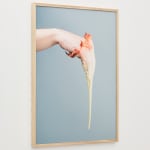Nona Inescu
39 3/8 x 27 1/2 in.
Nona Inescu’s framed photograph Brugmansia (2021/2024) is inspired by the interplay between human and plant life. The image shows a delicate flower, a Brugmansia, penetrated by a human hand, blurring the line between the natural and the human, the organic and the bodily. This investigation of the human-nonhuman relationship is part of Inescu’s broader inquiry, which she explores in her solo exhibition Daisyworld at Brooke Benington, using photography and sculpture.
Drawing from the Gaia hypothesis and the hypothetical world model developed by James Lovelock and Andrew Watson, Inescu explores the symbiotic relationships that exist between humans and nature. The hand inserted in the flower exemplifies this complicated dynamic, being simultaneously caring and intrusive, gentle and violent.
Native to South America, Brugmansia is a plant that no longer grows in the wild but continues to be cultivated for its psychotropic properties, traditionally used by Andean shamans to induce trance states. In Nona Inescu’s work, the hand appears both entrapped by the flower and as though it wears it like a mask. This subtle gesture creates a connection between evolutionary adaptation, transformation, and mysticism, dissolving the boundaries between cultural symbols and natural phenomena.
Exhibitions
Daisyworld, Brooke Benington, London, UK (2024)The Venus Trap, solo presentation with SpazioA Gallery at fiac! (2021)



